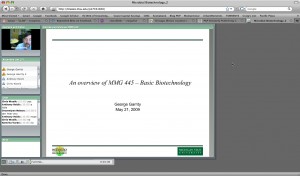Maximizing the Reach of a Graduate Research Journal Through Open Source Tools and Social Media: The Session Blog
Presenter: Rajendra Bose
July 10th, 2009 at 3:30 p.m.
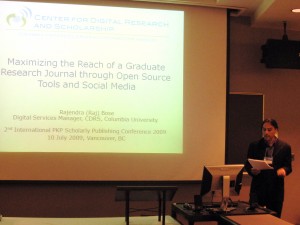
(used with permission from Raj Bose)
Background Info
Cultural Formations is an online journal (due to launch next month) that is open-access and peer-reviewed. The Center for Digital Research and Scholarship (CDRS) collaborated with Columbia University’s Teachers College to form Students for a Cultural Studies Initiative (SCSI). This project has grown to become more than just an online journal, using the concepts of Web 2.0 and Social Media as well as a research repository, Academic Commons.
As quoted on the Cultural Formations website, the journal-plus project has “…three integrated elements: an online journal of peer-reviewed articles, a blog for discussion of published articles and works in progress, and a wiki to serve as a “Wikipedia” of cultural studies and education.”
Session Overview
Graduate students at Columbia University and the Teachers College joined forces to form SCSI. Over the past year, they have worked hard to start a “journal-plus” – an online space that looks at cultural formations including youth culture, media, music, art, film and ethnicity, etc. Their goal is to not only publish research but to be accessible to the entire community, not just academic scholars. Along the way they were faced with significant challenges (examples include web design, technical problems with layout of the vastly different programs and challenges from having multiple partners with decision-making authority). They are however on schedule to launch their site next month. (Please stay tuned to this blog for the launch announcement!)
Services they hope to provide
- Publications – e.g. online books, journals
- Conferences
- Academic Commons
- Wikischolars
An example of what their website will look like:

(Used with permission from Raj Bose)
The goals of the Cultural Formations site are three-fold:
- authority of a journal
- immediacy of a blog
- what’s new and emerging in wiki format
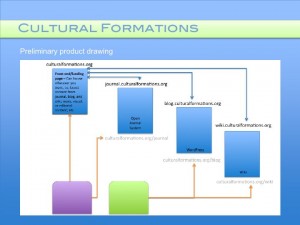
(Used with permission from Raj Bose)
The site is scheduled to launch in August 2009 at Culturalformations.columbia.edu (URL may change prior to launch).
Questions from the audience
1. Impressive. Will you open this up to the public as open source?
Yes, we are using all open access materials. The idea is to share it with the rest of the community, Users may have to connect with us to get a user profile as it may be too expensive to allow it open to all users at once. There likely will be a basic free level, and we may charge for some of the more advanced functions. We feel the site will have longevity with the article content/repository.
2. Is there a similar movement in other universities?
Yes, but the idea right now is to work with university presses and authors right here to get the right agreements.
3. Is there going to be any co-ordination with other groups?
Already there are 50-100 student journals with OJS [Open Journal System]. You especially want this system for longevity when a student group starts to fade out, this will help. The university hosting this site will help keep those groups up and running.
4. What about groups with other levels of education and how this may be used?
This idea is not a typical journal, but the idea to connect a blog and a wiki so that other members of community can join or help is amazing and very inclusive. Because of this, there will only be a light peer review. They partners want to keep this as open as possible.
Related Links
Center for Digital Research and Scholarship (CDRS)

Open Archives Initiative Object Reuse and Exchange (OAI-ORE)
July 10, 2009 Comments Off on Maximizing the Reach of a Graduate Research Journal Through Open Source Tools and Social Media: The Session Blog
Enriching Digital Citation Networks using Web 2.0 Principles: The Session Blog
Presenter: James Williams, Session Abstract

July 10, 2009 at 4:30 p.m.

Photo taken at PKP 2009, with permission
Background
James Williams is Manager, Information Systems at the eScholarship Research Centre at The University of Melbourne (http://www.esrc.unimelb.edu.au). His background is in Computer Science and Linguistics. James’ work focuses on eResearch and eScholarship, archiving and print on demand.
Session Overview
This session was a technical session, which laid the context and groundwork for a plug-in aimed at leveraging the network for citations. This session also highlights that some of the features of this plug-in are about to be implemented in the Referral plug-in coming with OJS 2.3. The author is planning to take his plug-in further by building on the work that has been done with the OJS Referral plug-in.
The context and groundwork included: Scholarly Contribution and Statistical Measurement; Bibliometrics – the h-Index and Journal Impact Factor; Indexes, Citators, Aggregators, etc.; What is Scholarship? What is Significant?; Developing Online Research Support Infrastructure; Scope – Scholarly Publishing and OJS Development. The key driver behind the paper had been to lead up to a plug-in which could capture and expose citation data, though this has been, to a certain extent, scooped by the Referral plug-in in the coming OJS 2.3. So OJS created a “heart broken Australian”, though one who is expected to make a full recovery.
In Australia, extensive dialogue around the measurement of academics’ scholarly research. Much of this is controversial. One key measure discussed is citation measures. Two citation measures come up in these discussions: the h-index and the journal impact factor. Many questions have been raised about this and attempts made to improve these measures, but questions remain about the extent to which they can be relied upon. The h index is from a paper by Hirsh, (2005). Crudely, it is the average number of citations that an author’s publications achieved in a year. Though its calculation is more complex than this.
Further problems with citation measures include statistical considerations with these measures which vary greatly between disciplines, so citations counts can vary greatly for statistical reasons. The source of these citations is the different indexes (Scopus, ISI Web Of Science, PubMed, Google Scholar) though each of these measures citations differently.
So, in general, what is needed is to develop intelligent digital citation networks, increase the discoverability of significant research contributions, harness the footprints caused by active network behaviour, provide greater statistical detail for transparency, and surface this information as much as possible for richer bibliometric reporting.
So, more specifically, what is needed is to track referrer information where it’s available: referring website/link/journal, date of referral and number of incoming hits from each referrer. As each referring URL, site, or journal is detected, it then becomes a known information source – an external, digital citation. We then surface this URL, site, or journal on the originating journal. Users of our (originating) journal, unaware of the external citation, can then find other people referring to this resource, and so, the networked community expands, develops, and evolves. This is the intent behind our planned digital citation plug-in, but which, as previously mentioned has been partially scooped by the Referral plug-in in OJS 2.3. So we are going to look at the Referral plug-in and talk further with PKP about this and build on the work that PKP has done.
Session Questions
Q. I’d like to know more about the h index?
A: Hirsh (2005) and others have expanded this. Peter Jascoe has also written a paper on this
Q. What software should use would where citations need to be checked in the publication process? How can we auto check and fix citations?
A. For OJS, the Resolver plug-in will help. L8X could also help.
References and Related Links
eScholarship Research Centre, University of Melbourne
Hirsh, J.E. (2005). An index to quantify an individual’s scientific research output. Retrieved on July 12, 2009 from http://www.cs.ucla.edu/~palsberg/hirsch05.pdf
Top Scholars in Computer Science, as calculated by the h index
What is Web 2.0? (includes translations in Chinese, French, German, Italian, Japanese, Korean, Spanish)
July 10, 2009 Comments Off on Enriching Digital Citation Networks using Web 2.0 Principles: The Session Blog
From Pedagogy to Androgogy: Using OJS to Immerse Students in Peer-Review Publishing: The Session Blog
Original Abstract Title: An Online, Open Access, Student-Authored and Peer-Reviewed eJournal in Biotechnology
Presenter: George M. Garrity
July 10th, 2009 at 9:30 a.m.
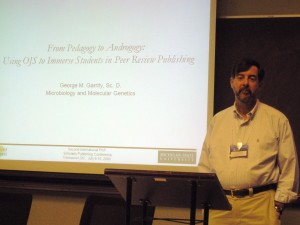
(Used with permission from George Garrity)
Background info
A course (MMG 445 Basic Biotechnology) taught at Michigan State University by George Garrity has been a leader in student open access knowledge publication. The curriculum ensures its students learn the rigorous method of peer review in their field by becoming both authors and reviewers. The course and website follow Creative Commons licensing and pay particular attention to intellectual property. The students hope to be published at the end of this course after surviving the said scientific methods of journal editing and learning about biotechnology to boot.
Session Overview
The session starts with Professor Garrity describing a 20-year old course description that claims to deliver thoroughly out-of-date biotechnology topics and methods. You would think this would mean a zero percent class registration, but in contrast the class has been increasing in size every year and the university has placed a cap at 50 students! Word of mouth has ensured that this important course for all students is continued. Why is this course important you ask? Garrity goes on to explain that there are 5 essential elements students need to possess and are rarely taught in school:
- Curiosity
- Open to new ideas
- Problem solving
- Critical reading and listening skills
- Ability to express oneself clearly (written and verbal)
He continues on to describe what happens in the real world and skills you need to possess to become successful in your field:
- work on multidisciplinary teams
- be adaptable
- ability to acquire new skills quickly.
He shows how the course has changed over the 10 past years and how the course has come from a traditional lecture based series to a now completely virtual university with all lectures given online and students able to blog/chat online with each other and professor at the same time. He has instituted a blog for students to ask questions about the given weekly lecture (and this is the class participation mark). The students do not get away with mindless, redundant questions either. They will get thrown back to the students to revise.
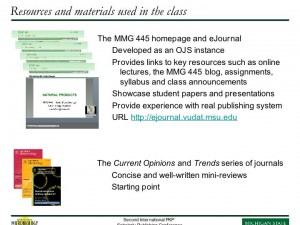
(Used with permission from George Garrity)
The course is structured into 4 assignments:
- Review paper (topic of their choice from Current Biotechnology) 30%
- Student Reviewer (4 other student papers) 30%
- Presentation of their paper 30%
- Class Participation 10%
Garrity and invited expert guest lecturers ensure that the whole process is valid and conforms to proper methodology. They also ensure that students are true to their said interests and get the work authored and reviewed in a timely fashion. The whole process has to be completed in one academic semester (13 weeks). There is a 70% acceptance rate and students are held to high standards. He relates to the class the importance of publication and how the scientific community uses this process to communicate, gain recognition and as a tool of quality control.

(used with permission from George Garrity)
The student publications can be viewed online via the Open Journal System and have been thoroughly cited in Google scholar. These review article have been cited by other peer-reviewed articles multiple times, have been published by Elsevier and have been used in hiring interviews. Student Alumni have come back to class to give ringing endorsements of the reality of the class and well as to become teaching assistants or guest lecturers.
One of the biggest components is the no-tolerance policy on plagiarism which is painfully spelled out by Garrity in class and even goes on to tell the students how he will catch them. You would think this would turn students off of the idea, but he still gives examples of multiple plagiarized papers each semester.
As stated above the course goes beyond plenary sessions to include the above unique writing as well as faculty and student-generated online videos. They do this using Web 2.0 online programs (Adobe Connect Pro/Skype) which are similar to Jove (Journal of Visualised Experiments). Please see the YouTube tutorial below for an example of how Adobe Connect Pro works. These are easy to use and cheap to install in the classroom.
Questions from the audience
Most questions centred around plagiarism and how he could detect the multiple examples.
The shared techniques from simplest to complex were:
- multiple different fonts in a paper
- multiple writing styles in a paper
- undergrad level English/grammar forging into graduate level writing and then back again
- use of technically perfect writing, however strung together in such a way that it made no scientific sense
A specific technique he used centred around an “anchoring” word which is a word that shouldn’t be used commonly that appears. He places this word with three or four surrounding words in google and tries to find wrong citations or mis-citations. All evidences of plagiarism is reported back to the Academic Council and Dean.
Notable Accomplishments
The eJournal continues to increase in circulation with >92,400 downloads to date (Source).
Seven student articles have been downloaded > 2000 times and 23 papers over 1000 times (Source).
The eJournal has been chosen as the first place recipient in the 2007 MSU-AT&T Faculty-Staff Awards for Instuctional Technology.
Related Links
Scientific Writing Reference texts

July 10, 2009 1 Comment
